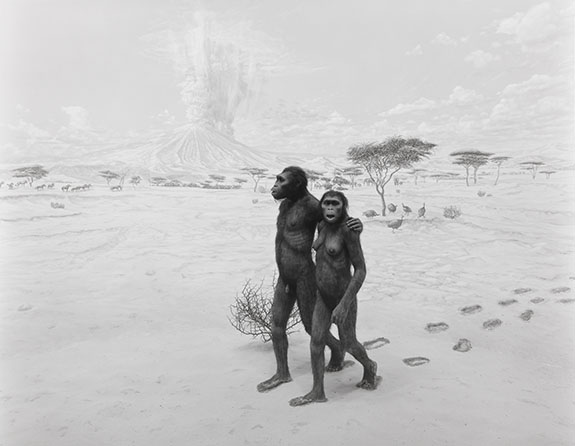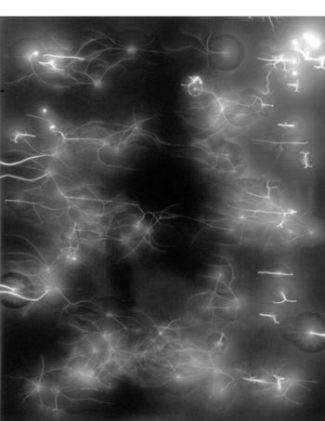by Max Blue

Japanese-born New York photographer Hiroshi Sugimoto has long made work emphasizing the human narrative and the passage of time. In one of his earliest and best-known bodies of work, Theaters,each photograph is a single, long exposure made over the duration of a film’s projection in a movie theater. The result is a totally white, glowing screen. When looking at Theaters, we do so knowing that each image contains within it every frame of a feature-length movie. In his latest exhibition at Fraenkel, B.C., Sugimoto stays true to form, presenting photographs deeply entrenched in the narrative of human evolutionary history, highlighting the medium as one of documentation and record keeping, inherently bound up in its relation to narrative and time.
In this 15-piece exhibition, which draws from several prior series — Dioramas, Seascapes, Lightning Fields, but notably not Theaters — Sugimoto demonstrates that two-hour exposures aren’t the only way to put photography in dialogue with the passage of time. The exhibition ranges from playful to somber, with works like Earliest Human Relatives (1994), placing a foot in each camp. The now-iconic image, of a diorama in a natural history museum, shows two
Sugimoto, quoted in the exhibition press release, says, “If a photograph is able to stop time, then a fossil can do the same thing.” To underscore that point, several fossils are strategically placed throughout the exhibition, amplifying the anthropological undercurrent. Photography, of course, plays a key role in driving this line of inquiry. Its position, from both an evolutionary and technological perspective, is plotted at many points in the exhibition. In Praise of Shadows, 980809 (1998), a shot of a single blazing flame, is a fine example. It suggests fire, electricity and photography as some of the more noteworthy steps along that trajectory.
All the pieces in B.C.contribute to the overarching sense of the primordial. The feeling runs particularly strong in photos taken from two series, Seascapes and Lightning Fields. Looking out over the misty seascape of Mediterranean Sea, Cassis (1989), for example, we feel as if we are about to witness the emergence of something from the ocean’s depths; and since, by this point

in the show, we’ve already seen Sugimoto’s images of ocean floor dioramas, we suspect what that might be. Similarly, images from the Lightning Fields series evoke of the spark of conception at a Paleolithic level: the dawn of humankind.
While all of this work is visually stunning and thematically awe-inspiring, the exhibition as a whole feels like a parade of greatest hits. The focus on a theme already central to the artist’s work practically forecloses the possibility of a fresh viewing experience. Yet there’s no way to really undermine an artist of Sugimoto’s stature. The preexisting unity of Sugimoto’s career- spanning themes, his aesthetic proclivities, and the richness of each photograph make any show of his worth seeing. B.C.is no exception.
# # #
Hiroshi Sugimoto: B.C. @ Fraenkel Gallery through April 25, 2018.
About the author:
Max Blue, a Northern-California native and life-long resident, is a writer of criticism, fiction, and poetry. He has studied art history and photography at the San Francisco Art Institute. His writing has appeared in Art Practical and Digital America.